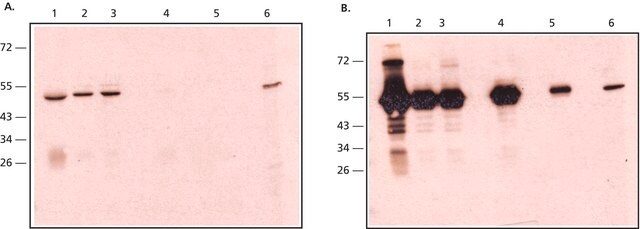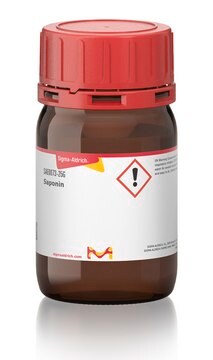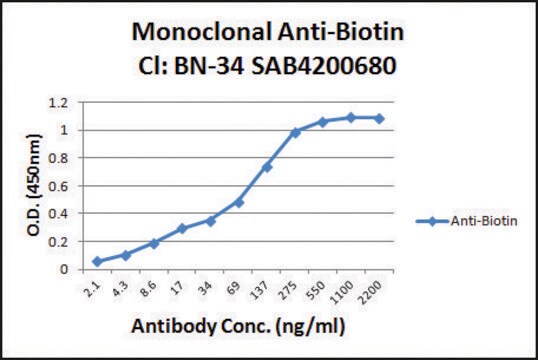推薦產品
生物源
mouse
品質等級
共軛
peroxidase conjugate
抗體表格
purified immunoglobulin
抗體產品種類
secondary antibodies
無性繁殖
RabT-50, monoclonal
形狀
buffered aqueous solution
物種活性
rabbit
應無反應活性
human, horse, bovine, cat, rat, chicken, pig, goat, monkey
濃度
2.5-5.0 mg/mL (antibody)
技術
immunocytochemistry: suitable
indirect ELISA: suitable
western blot: 1:10,000-1:20,000 using 3T3 cell extracts using Anti-Actin (20-33), Catalog Number A5060, as the primary antibody
western blot: 1:10,000-1:20,000 using Hela cell extracts using Anti-Actin, N-terminal, Catalog Number A2103, as the primary antibody.
同型
IgG1
運輸包裝
dry ice
儲存溫度
−20°C
目標翻譯後修改
unmodified
一般說明
Monoclonal Anti-Rabbit IgG, Native-Peroxidase is a purified immunoglobulin fraction of monoclonal Anti-Rabbit IgG, Native (mouse IgG1 isotype) isolated from hybridoma cell culture of the RabT-50 hybridoma, conjugated to horseradish peroxidase (HRP).
Rabbit immunoglobulins are widely used as primary antibodies in many analytical and research techniques. In immunoprecipitation assays, when target proteins are studied using rabbit primary antibody, the secondary anti-rabbit antibody used for protein detection also recognizes the heavy (50 kDa) and light (25 kDa) chains of the rabbit immunoprecipitating antibody. Consequently, this may conceal the protein of interest, as many proteins appear in the molecular weight range of the immunoglobulin heavy and light chains. The use of monoclonal anti-rabbit IgG-native-peroxidase as the secondary antibody eliminates this hindrance because the antibody is specific for non-reduced rabbit IgG and does not react with reduced rabbit IgG. Moreover, this antibody product does not react with human, monkey, bovine, horse, pig, goat, cat, rat, and chicken IgGs. Thus, this product reduces the background staining that is frequently observed with polyclonal secondary antibodies.
特異性
Monoclonal Anti-Rabbit IgG, Native-Peroxidase reacts specifically with non-reduced rabbit IgG and does not react with reduced rabbit IgG.
免疫原
Enriched fraction of rabbit IgG light chain.
應用
Monoclonal Anti-Rabbit IgG, Native-Peroxidase antibody produced in mouse has been used in:
- immunoblotting
- immunoprecipitation
- western blotting
外觀
Solution in 0.01 M phosphate buffered saline, pH 7.4, and 0.05% MIT.
免責聲明
Unless otherwise stated in our catalog or other company documentation accompanying the product(s), our products are intended for research use only and are not to be used for any other purpose, which includes but is not limited to, unauthorized commercial uses, in vitro diagnostic uses, ex vivo or in vivo therapeutic uses or any type of consumption or application to humans or animals.
未找到適合的產品?
試用我們的產品選擇工具.
訊號詞
Warning
危險聲明
危險分類
Skin Sens. 1
儲存類別代碼
12 - Non Combustible Liquids
水污染物質分類(WGK)
WGK 3
閃點(°F)
Not applicable
閃點(°C)
Not applicable
Deacetylation of FOXO3 by SIRT1 or SIRT2 leads to Skp2-mediated FOXO3 ubiquitination and degradation
Wang F, et al.
Oncogene, 31(12), 1546-1546 (2012)
SIRT2 suppresses adipocyte differentiation by deacetylating FOXO1 and enhancing FOXO1's repressive interaction with PPARgamma
Wang F and Tong Q
Molecular Biology of the Cell, 20(3), 801-808 (2009)
A novel Cep120-dependent mechanism inhibits centriole maturation in quiescent cells
Betleja E, et al.
eLife, 7, e35439-e35439 (2018)
Márcio Simão et al.
BioFactors (Oxford, England), 45(4), 583-597 (2019-05-28)
HFE-hemochromatosis is a disease characterized by a systemic iron overload phenotype mainly associated with mutations in the HFE protein (HFE) gene. Osteoarthritis (OA) has been reported as one of the most prevalent complications in HFE-hemochromatosis patients, but the mechanisms associated
Diego M Marzese et al.
Neuro-oncology, 16(11), 1499-1509 (2014-06-28)
The brain is a common target of metastases for melanoma patients. Little is known about the genetic and epigenetic alterations in melanoma brain metastases (MBMs). Unraveling these molecular alterations is a key step in understanding their aggressive nature and identifying
我們的科學家團隊在所有研究領域都有豐富的經驗,包括生命科學、材料科學、化學合成、色譜、分析等.
聯絡技術服務









